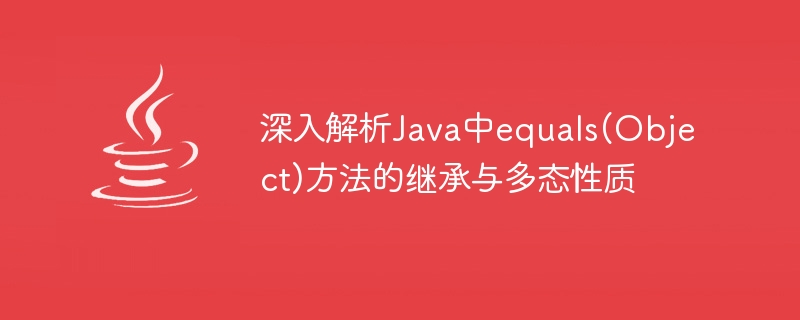

In-depth analysis of the inheritance and polymorphic properties of the equals(Object) method in Java
Inheritance and polymorphism are two important object-oriented features in the Java language. The equals(Object) method in Java is a method used to compare whether two objects are equal. Before we deeply analyze the inheritance and polymorphic nature of the equals(Object) method in Java, let’s first understand the definition and purpose of the equals(Object) method.
In Java, the equals(Object) method is a virtual method defined in the Object class. It is used to determine whether two objects are equal. The default implementation of the equals(Object) method determines whether two objects are equal by comparing their memory addresses. Therefore, if you want to compare whether the contents of two objects are equal, you need to override the equals(Object) method in a specific class.
Inheritance is an important feature of object-oriented programming, which allows one class to inherit the properties and methods of another class. When a class inherits from another class, it inherits all the non-private properties and methods of the other class. In Java, the equals(Object) method can also be inherited, and subclasses can directly use the equals(Object) method of the parent class to compare whether two objects are equal.
However, for specific subclasses, the equals(Object) method of the parent class may not be able to meet the needs of the subclass. Therefore, subclasses can also override the equals(Object) method to implement their own equality judgment logic. When overriding the equals(Object) method, you usually need to call the equals(Object) method of the parent class first to compare the properties of the parent class, and then compare the properties unique to the subclass.
Polymorphism is another important feature of object-oriented programming, which allows an object to be used in different ways in different contexts. In Java, the equals(Object) method also has polymorphic nature. In other words, you can use the reference of the parent class to call the equals(Object) method of the subclass.
For example, suppose there is a parent class Animal and a subclass Cat that inherit from Animal. There is an attribute name in the Animal class that is used to store the name of the animal, and the equals(Object) method is overridden to compare whether the name attributes of two Animal objects are equal. The Cat class inherits from the Animal class, and adds a new attribute color to store the color of the cat, and overrides the equals(Object) method to compare whether the color attributes of two Cat objects are equal.
public class Animal {
protected String name;
public Animal(String name) {
this.name = name;
}
@Override
public boolean equals(Object obj) {
if (this == obj) return true;
if (obj == null || getClass() != obj.getClass()) return false;
Animal animal = (Animal) obj;
return Objects.equals(name, animal.name);
}
}
public class Cat extends Animal {
private String color;
public Cat(String name, String color) {
super(name);
this.color = color;
}
@Override
public boolean equals(Object obj) {
if (this == obj) return true;
if (obj == null || getClass() != obj.getClass()) return false;
if (!super.equals(obj)) return false;
Cat cat = (Cat) obj;
return Objects.equals(color, cat.color);
}
}In the above code, the Cat class overrides the equals(Object) method, first calling the equals(Object) method of the parent class Animal to compare the name attribute, and then comparing the color attribute. In this way, the custom equality judgment logic of the subclass Cat is implemented.
Through inheritance and polymorphism, we can see that the equals(Object) method of the parent class can be directly inherited and used by the subclass, and the subclass can also override the equals(Object) method according to its own needs. , implement your own equality judgment logic. At the same time, the equals(Object) method of the subclass is called through the reference of the parent class, realizing the application of polymorphism.
To summarize, through an in-depth analysis of the inheritance and polymorphism of the equals(Object) method in Java, we can find that inheritance and polymorphism provide a flexible implementation method for the equals(Object) method. Through inheritance, subclasses can directly inherit and use the equals(Object) method of the parent class; through polymorphism, we can use the reference of the parent class to call the equals(Object) method of the subclass, realizing dynamic binding of methods. This makes the equals(Object) method more flexible and scalable, and can meet the equals judgment needs of different types.
The above is the detailed content of Discuss the polymorphic nature and inheritance mechanism of equals(Object) method in Java. For more information, please follow other related articles on the PHP Chinese website!




